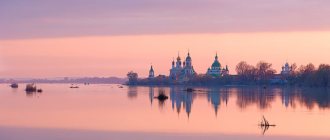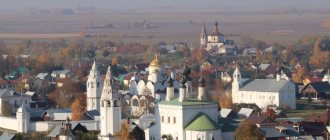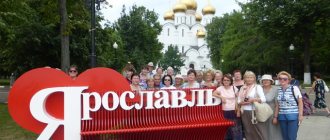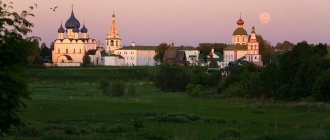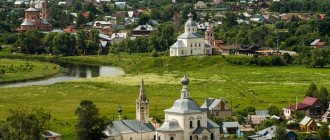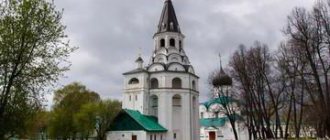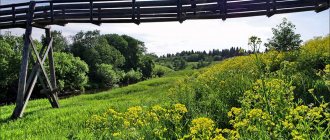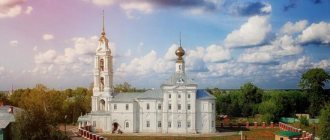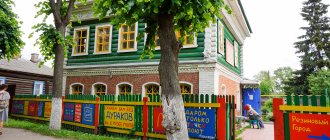Suzdal will celebrate its 995th anniversary on August 11, 2021. A city with an amazing fate, which has more than once been restored like a Phoenix from the ashes after fires caused by an external enemy and the devastation of internal princely civil strife. However, ancient Suzdal managed to preserve its cultural past. The Nativity Church of the Suzdal Kremlin is a UNESCO World Heritage Site; the city itself is part of the Vladimir-Suzdal Museum-Reserve.
This intimate town is remote from transport routes. However, you can get to it from Moscow faster than getting to a remote residential district of the capital during rush hour - in three hours. The high-speed train Moscow - Nizhny Novgorod (1 hour 40 minutes) and regular bus service with Vladimir (45 minutes) will take you to the heart of ancient Russian architecture.History and description of Suzdal
Suzdal is a city in the Vladimir region, located on an area of 15 square meters. km, with a population of 10 thousand people. Suzdal is located on the Kamenka River, 230 km from Moscow and 23 km from Vladimir.
Suzdal is a picturesque town that is part of the Golden Ring of Russia, an open-air museum where unique ancient monuments are combined with natural splendor
The first notes about Suzdal date back to 1024: the chronicle said that the populated area was small, but had its own defensive structures. In 1107 the city was conquered by the Bulgars. From the beginning of the 12th century, it became the center of the Rostov-Suzdal principality under the leadership of Yuri Dolgoruky. At the same time, monasteries and temples began to be built here. Since 1392, Suzdal became part of the Moscow Principality. After the 1570s (the time of the abolition of the oprichnina), the settlement received the status of a “royal homeland”; the royal family often visited here. During the Time of Troubles, Suzdal was attacked by the Crimean Tatars, experienced diseases and fires, which changed its appearance. However, the city quickly recovered: new monasteries were erected and the previously built Kremlin was rebuilt.
Suzdal has always been famous for its religious buildings
By the 17th century, Suzdal had become an Orthodox center with 11 monasteries. With the beginning of the reign of Peter I, the city began to be considered a district town. Later, by decree of Empress Catherine II, a trade route was built through it, connecting the south of the country with the north. From that moment on, stone buildings began to be built in Suzdal and trade with other cities began. However, after the appearance of the Nikolaev railway, which went far from Suzdal, it ceased to be a trading center, turning into a quiet provincial settlement for several centuries. During Soviet times, work was actively carried out here to destroy churches; more than 15 shrines were demolished. Today, Suzdal is part of the “Golden Ring” of Russia as a preserved architectural monument, spiritual and tourist center.
Kideksha
A small village a few kilometers from Suzdal downstream of the Kamenka, at its confluence with the Nerl, was for some time a strategic point. Here was the residence of Yuri Dolgoruky, who preferred to live outside the city. But the main attraction of Kideksha is the first white stone temple in North-Eastern Russia. This is the Church of Boris and Gleb, built in 1152. Of course, the single-domed temple has changed since its construction, but its appearance still reminds us how harsh life was here. It seems that in order to turn a church into a fortress, it is enough to close the narrow windows and turn them into loopholes.
In the village with a population of 140 people, monuments from the later 18th century have also been preserved - the Tent Bell Tower and the Church of St. Stephen.
Table: how to get to Suzdal
| Departure city | Bus | Automobile |
| Moscow | More than 10 flights depart from the Shchelkovskaya metro station every day. Travel time is approximately 4 hours. Trip cost is from 550 rubles. | Length - 221 km. Travel time - 2-3 hours. Route - M7. |
| Saint Petersburg | There are no direct flights. | Length - more than 900 km. Travel time: 9–10 hours. Routes: M10, A108, M8. |
| Vladimir | Buses depart from the bus station every 15 minutes. Travel time - 50 minutes. Ticket price - from 150 rubles. | Length - 39 km. Travel time: 25–40 minutes. The route is M7. |
Venerable Bell Tower
The tallest building in the city is located right here - this is the Venerable Bell Tower. Fortunately, you can climb it and see the best panorama of the center and surrounding area. In good weather, all 53 Suzdal churches will be visible.
Red Square
Entrance fee : 50-150 rubles
Sights of Suzdal
Suzdal attracts with its atmosphere of purity and spiritual enlightenment. Despite the fact that the city is small, it contains a large concentration of ancient Russian monuments and attractions that bear the stamp of history and art.
The tourist map of Suzdal will help you quickly find all the points of interest
Suzdal Kremlin
The beginning of the history of the Suzdal Kremlin is considered to be the 11th century, when local residents began to need a defensive structure in order to escape the attacks of neighboring peoples. On one side, the Kremlin was protected by the Kamenka River, on the other, by man-made earthen ramparts and deep ditches. For several centuries, the Kremlin served as a bishop's residence, on the territory of which there were residential buildings, bishops' chambers and churches.
The oldest building of the fortress that has survived to this day is the Cathedral of the Nativity of the Virgin from the 12th century. It stands out for its golden gates, created by local craftsmen at the beginning of its construction.
The western and southern golden gates of the Nativity Cathedral in Suzdal are a masterpiece of Russian applied art of the 13th century
The neighboring 17th-century St. Nicholas Church was transported to the Kremlin territory from the Yuryev-Polsky district. Currently, it is operational and houses an icon-painting workshop.
St. Nicholas Church is a wonderful example of ancient “kletsky” churches
The bishop's chambers, built in the 15th century, occupy an area of 800 m2 and are divided into several buildings. They contained cells for clergy and utility rooms. Now the bishop's chambers house the refectory and the Vladimir-Suzdal Museum. The exposition is an exhibition of rare icons, ancient Russian paintings, as well as ancient household items.
One of the museum's halls is interesting - the Cross Chamber, built for important receptions. It reproduces the solemn interior of the time of Ivan the Terrible: there are icons on the walls, a huge table and a bishop’s chair stand in the center of the room, and the corners are decorated with several tiled stoves.
The Bishop's Chambers were built over several centuries, from the 15th century until the 17th century.
Address: Alexey Lebedev Street, 8. Opening hours: from 10:00 to 18:00 (except Tuesday and the last Friday of each month). Entrance tickets to the Kremlin territory: 250 rubles. — for adults, 120 rub. - for children. 350 rub. — a comprehensive ticket that includes visits to the museum and temples.
Photo gallery: Vladimir-Suzdal Museum
The bishop's chair and all the furniture in the Cross Chamber date back to the 18th century.
The museum has an exhibition “Suzdal 100 years ago”
Stoves dating back to the 18th century were intended for both heating and decoration
The Jordan Canopy is a unique monument of ancient Russian art of the late 17th century, the only one preserved in Russia
The exhibition “History of Suzdal” presents a model of the city at the turn of the 12th-13th centuries
The cross chamber, occupying 300 square meters. m, amazes with its airiness - its hall does not have a single pillar
Spaso-Evfimiev Monastery
The Spaso-Evfimiev Monastery dates back to 1352. It is located on the bank of the river, and is named after the first abbot of the monastery - Euthymius, now a revered saint. The history of the monastery is ambiguous - in addition to the monastery, various institutions were located here for several centuries:
- by order of Catherine II in the 1760s, wards for mentally ill prisoners were located within the walls of the monastery;
- in 1919–1923 there was a political camp there;
- during the Great Patriotic War, the monastery became a prison for German prisoners of war;
- in the 1970s it was reclassified as a colony for teenagers.
The buildings of the monastery burned several times, and the buildings that have survived to this day date back to the end of the 17th century. The monastery owns:
- Entrance (Passage) 22-meter tower of the early 17th century;
- Annunciation Gate Church;
- Spasskaya Church, erected over the burial place of St. Euthymius in 1564;
- the belfry, where there is an ancient bell preserved from the 16th century;
- Assumption Church built in 1525;
- single-domed St. Nicholas Church of the 17th century.
Photo gallery: monastery buildings
The lower part of the tower is distinguished by its severity, and its upper tier is richly decorated with decorative elements of Russian patterning.
The Annunciation Gate Church was built as a holy gate at the turn of the 16th-17th centuries
The Spasskaya Church was decorated with paintings back in the 16th century, but by the middle of the 17th century these frescoes had already fallen into disrepair, and in 1689 they were replaced by a new painting, which has not yet been cleared
Currently the belfry has 17 bells that ring five times a day
Adjacent to the Assumption Church from the side of the Diomidovsky chapel is a monument of civil architecture of the 17th century - the Archimandrite building
St. Nicholas Church was a hospital church; two-tier hospital wards are adjacent to it
Today the monastery is part of the Suzdal Museum-Reserve, and its ten exhibition complexes tell about the history of the Suzdal people and their culture. Along the walls of the monastery there are burials with the graves of princes Dmitry Pozharsky and Ivan Strig-Obolensky.
Address: Lenina, 135. Opening hours: from 10.00 to 18.00 - daily. Ticket price: 400 rub. — for adults, 200 rub. - for children and students. Cost of climbing to the belfry: 200 rubles. — for adults, 100 rub. - for children.
Photo gallery: museum exhibitions of the monastery
In the building of St. Nicholas Church there is an exhibition “Golden Pantry”, where you can see many products made of precious metals
The exhibition “The Book of Six Centuries”, revealing the great significance of books in the life of mankind at all times, their depth and wisdom, is located in five chambers of the Archimandrite building
The exhibition “Russian Icon of the 18th–20th centuries”, located in the Archimandrite building, presents the most valuable icons with frames decorated with precious stones
A unique museum exhibition is the Spaso-Preobrazhensky Cathedral of the monastery, the walls of which were painted in 1689 by an artel of Kostroma artists under the leadership of Guriy Nikitin, the largest Russian master of frescoes and icon painting of the 17th century.
The exhibition “History of Suzdal Monasteries”, located on the first floor of the Brotherhood Building, tells about the history of the monasteries of Suzdal, which was considered one of the religious centers of Russia
The exhibition “Interweaving of Fates” opened in the Fraternal Building in May 2003. The idea of the exhibition is to combine exhibitions about people and events that are in one way or another connected with Suzdal
The exhibition “Suzdal Prison” is located in the Prison Building and represents Suzdal no longer as a spiritual capital, but as a place of exile
The Museum of Naive Art of Russia operates in the Assumption Refectory Church; it is an exhibition of works by self-taught artists
The Apothecary Garden is a unique open-air exhibition where about 60 species of medicinal plants are grown.
The exhibition “Suzdal in Cinema” is open in the Proezdnaya Tower and tells about the films that were filmed in the city, of which there are about 80
Alexander Monastery
The Alexander Monastery is an ancient white-stone monastery, founded in 1240 on the left bank of the Kamenka River. According to legend, the monastery was built by order of Alexander Nevsky in honor of the victory over the Swedes. In 1608, all the buildings were destroyed by fire, but the monastery was partially restored. Few buildings have survived to this day:
- Church of the Ascension;
The Ascension Church was built in 1695 - Bell tower;
- part of a stone fence.
The monastery served as a burial vault for Suzdal autocrats in the female line - here you can find the graves of princesses Maria and Agrippina. The monastery has not worked since 1764, so its buildings fell into disrepair. Only after reconstruction in 2006 was the Lavra revived and given to the diocese.
Address: Gasteva street, 15. Opening hours: 24 hours a day.
Pokrovsky Monastery
The Intercession Monastery, founded in 1364, is an ensemble of religious buildings surrounded by a white stone wall. Euthymy of Suzdal made a great contribution to its development, thanks to whom the attention of the rulers was paid to the monastery, which led to further construction. The monastery flourished in the 16th century, a period when the holy life attracted women from the upper classes. Here the wives of the kings were tonsured: Anna - the wife of Ivan the Terrible, Evdokia Lopukhina - the wife of Peter I, Ekaterina - the wife of Vasily Shuisky and others. From 1923 to 1992 the monastery did not work. Currently, the monastery operates; the nuns themselves conduct excursions to the shrines.
In the 16th-17th centuries the Intercession Monastery was one of the largest in Rus'
The ancient buildings of the monastery include:
- Intercession Cathedral (1510–1518);
- Tent bell tower (XVI-XVII centuries);
- Holy Gate and Gate Church of the Annunciation (1518);
- Refectory chamber with the Conception Church (1551);
- cookhouse (XVII century);
- Prikaznaya hut (early 18th century);
- stone fence with towers (XVII-XVIII centuries).
Within the walls of the place of worship are stored about 100 revered relics, including the relics of Hagia Sophia, the icon of St. Nicholas the Wonderworker with a particle of relics, the relics of the Matrona of Moscow and others.
Address: Pokrovskaya street, 76. Opening hours: from 10.00 to 18.00 - daily, except Wednesday and Thursday.
Photo gallery: buildings of the Intercession Monastery
The lower part of the Tent Bell Tower is the pillar-shaped Church of the Origin of the Honest Trees of the Holy Cross
The Holy Gate is unique in its function: it served simultaneously as a powerful fortress tower and a church
The refectory chamber with the Conception Church is more typical for Polish than for Russian architecture
Under the building of the Intercession Cathedral there is a tomb where nuns and elders of the monastery are buried: exiled queens, grand duchesses, noble women of the aristocratic families of Rus'
In the dungeon of the Prikaznaya hut there is a stone bag where the prisoners of the monastery were kept
The cookhouse has been used for cooking since the end of the 17th century.
St. Basil's Monastery
St. Basil's Monastery is the only monastery dedicated to Archbishop St. Basil the Great. The exact date of creation is unknown - written sources say that during the internecine wars of 1095 the monastery already existed. The monastery is located on the border of the city, on the road leading from the Kremlin to the village of Kideksha. Particles of the relics of Basil of Caesarea and the icon of Blessed Eudokia of Suzdal are kept here. Initially the monastery was male, and later became female. In 1923, the monastery closed completely, and warehouses were located in its premises. At the end of the twentieth century, the buildings again became churches, and the monastery was converted into a monastery. The main buildings of the monastery are:
- Vasilyevsky Cathedral (1662–1669);
- Sretenskaya refectory church (late 17th century);
- fence with low Holy Gate (XVII century).
Address: Vasilievskaya street, 32B. Opening hours: from 9.00 to 18.00 - daily, except Saturday and Sunday.
Photo gallery: buildings of the St. Basil's Monastery
A small refectory connects the three-tier bell tower of the 19th century to the cathedral
Sretenskaya Church is small, single-domed, with small windows and a complete lack of decor.
The monastery has its own hotel for 11 people, where pilgrims stay
Deposition of Robe Monastery
The Robe Deposition Monastery was founded in 1207 by Bishop John on the outskirts of the city at its highest point. Initially, the monastery was wooden; it was rebuilt into stone only in the 16th century. The monastery became famous for Euphrosyne of Suzdal, who lived within its walls and had the gift of healing. Legend says that the saint was the daughter of the Chernigov prince, and her wedding was supposed to take place in the monastery, but the groom died the day before the betrothal, and Euphrosyne decided to become a nun.
Today the monastery includes:
- The Robbery Cathedral is the oldest building on the territory of the monastery (early 16th century). It is decorated with a carved portal, pilasters and a porch with rich decoration;
- the double-arched stone Holy Gate, built in 1688;
- The 72-meter Venerable Bell Tower, erected in the 18th century;
- ruins of the Sretenskaya Refectory Church (built in 1882).
Address: Lenina street, 79. Opening hours: from 7.00 to 20.00 daily.
Photo gallery: buildings of the Deposition of Robe Monastery
In Soviet times, the Deposition of the Robe Monastery, like many Orthodox shrines, was closed; its premises housed a power plant
The most interesting building of the monastery is the double-tented Holy Gate with two arches of different sizes, decorated with stone carvings and tiles
The Venerable Bell Tower is one of the 40 tallest bell towers in Russia
Entry of Jerusalem and Pyatnitskaya churches
The Church of the Entrance to Jerusalem is located opposite the city square, in the very center of the city. It was built at the beginning of the 18th century on the site where a wooden church previously stood, and was consecrated in honor of the main Christian holiday - the Entry of Jesus into Jerusalem (Palm Sunday). The church was cold; no services were held there in winter. At the end of the century, it was decided to build another temple next to it - a warm one - in honor of Paraskeva Pyatnitsa, who with his appearance created a “paired” ensemble with the previously erected one. The bell tower and fence were destroyed during the Soviet period. Now the churches are active; services are held in them on weekends and holidays.
The Entrance of Jerusalem and Pyatnitskaya churches were built in 1707 and 1772, respectively.
Address: Kremlyovskaya street.
Gostiny Dvor
The trading house, built in the Empire style and called Gostiny Dvor, was designed by the architect Alexei Vershinsky (built in 1811). The trading area, divided into two buildings, was used not only as a place for selling and purchasing goods, but also as a room where people could communicate: an open gallery with columns was a kind of boulevard for walking. There were more than 100 different shops inside. From the original building, only the northern part of the courtyard has survived to this day. Today the building houses an entertainment center with shops and cafes.
The southern part of Gostiny Dvor was dismantled in 1924
Address: Lenin street, 63A.
Museum of Wooden Architecture
The Museum of Wooden Architecture represents more than twenty wooden buildings copying houses from tsarist times (XVII-XIX centuries). The complex project was carried out in the 1960s, when it was decided to try to preserve wooden architecture. It was possible to bring all the ancient wooden buildings from different parts of the Vladimir region to the outskirts of Suzdal and organize a full-fledged village. Now here you can find examples of houses belonging to different classes: a peasant’s hut, a merchant’s tower, a farm laborer’s shack or a blacksmith’s workshop. Barns, wells, and mills are also part of the museum complex. On the territory there are two churches of the 17th century, built without nails - Preobrazhenskaya and Resurrection.
In the Museum of Wooden Architecture, the peasant and merchant life of tsarist times has been recreated down to the smallest detail.
All buildings are architectural monuments. Inside each of the houses, the interiors of past centuries have been recreated; in them you can see furniture, Russian stoves, handicraft items, and dishes. In summer, the makeshift village hosts a cucumber festival and a crafts festival, and in winter, folklore festivals.
Address: Pionerskaya street, building 1. Opening hours: from 9.00 to 16.00 - in winter, from 9.00 to 21.00 - in summer. Closed: Wednesday and last Friday of the month. Entrance ticket cost: 350 rubles. — for adults, 150 rub. - for children and pensioners.
Museum "Shchurovo Settlement"
The Shchurovo Settlement Museum is located on the border of Suzdal and occupies an area of one hectare. The complex was created in 2008 for the filming of the film “Tsar” directed by Pavel Lungin. Today the exhibition represents a village from the time of Yuri Dolgoruky with copies of residential and outbuildings of the 15th century: dugouts, forges, barns, towers. Here you can attend master classes where you will be taught how to ride a horse, bake a loaf in an oven, or wield a sword. There is a zoo with pets for children. Historical reconstructions of battles are often carried out on the territory of the settlement.
The Shchurovo Settlement Museum is a unique place where you can plunge into the life of Ancient Rus' and learn about the traditions and culture of our ancestors
Address: Korovniki Street, 14. Opening hours: from 11.00 to 18.00 on weekdays, from 11.00 to 16.00 on Saturday, from 11.00 to 14.00 on Sunday. Ticket price - 350 rubles.
Posad House
The small stone house, called “Posadsky”, was built at the turn of the 17th-18th centuries in Western traditions. Currently, there is a museum here, where the environment in which the owner of the tavern lived in the 17th century has been recreated. The house from the inside consists of several parts:
- canopy;
- chulana—storehouses for supplies;
- lower room - a large living room with antique furniture and a Russian stove;
- the upper room was a small, bright room that served as an office and bedroom.
It is unknown who built the house:
- in the 17th century it belonged to the tailor Koska Dobrynka;
- then to the Bibanov family, who ran a tavern in the city;
- in the 19th century it was acquired by the merchant M. Boldin;
- the last private owner was S. M. Maltseva - it was from her that the museum acquired this house in 1970.
The Posad House Museum houses more than 150 exhibits telling about the life of old Rus'
Address: Lenin Street, 148. Opening hours: from 10.00 to 17.00 - Saturday, Sunday, Monday, Tuesday; 10.00 to 16.00 - Wednesday, Friday; Closed on Thursday.
Video: trip to Suzdal
General impressions
Suzdal is a fairly popular destination, especially within the Golden Ring, but there are no crowds of tourists and queues for museums. On the contrary, there is silence and tranquility here, which encourages long walks and allows you to truly feel this place. Its center has retained its ancient historical appearance, which is a rarity in Russia. Here you can really imagine that you are in the 18th century.
One of the disadvantages that almost all tourists note is the prices, which are not typical for a small town. Most establishments and hotels are designed for tourists, and since Suzdal is a popular destination, prices can be compared with Moscow. It is quite difficult to find inexpensive accommodation or a cheap cafe, so it is better to stay in Vladimir or Ivanovo.
What to see if you come to Suzdal with children
A great idea would be to visit Suzdal with your children:
- the younger generation can be shown the Kremlin with its ancient buildings and moats;
- in the Posadsky House, children will be told about the life of the middle class who lived at the end of the 17th century;
- The wax museum will introduce children to Russian emperors and princes;
The museum is open from 10.00 to 19.00 every day, and the ticket price is 250 rubles. for adults and 100 rub. for children. Address: Kremlyovskaya, 10B.
In three halls on an area of more than 200 sq. m visitors can see 150 figures of the most significant political and cultural figures of Russia from the 9th century to the present - Together with your child, it will be interesting to climb the high bell tower in the Spaso-Evfimiev Monastery, from where a picturesque view of the city opens;
- at the Museum of Wooden Architecture, kids will travel back to the times of Ancient Rus' and attend excursions that clearly tell about the formation of the Russian people;
- With children you can visit Torgovaya Square, where trade in handicrafts has been carried out for 800 years, and stroll through the small streets of Suzdal, each of which is decorated in ancient Russian traditions.
Museum of Wooden Architecture
Along with Yuri Bychkov, Alexey Varganov and Valentin Anisimov should be considered the “godfathers” of tourist Suzdal. On the initiative of the former, the St. Nicholas Church was transported to Suzdal back in 1960, and Anisimov was the main ideologist of the concept of the Museum of Wooden Architecture. It was this museum, located right on the banks of the Kamenka River, that laid the foundation for Suzdal as a tourist Mecca.
The buildings collected in the Museum of Wooden Architecture seem to model the plan of a Russian village in the 16th – 19th centuries. The center of the exhibition is the square on which there are two churches and a bell tower. From the square there are streets lined with authentic houses from the 17th and 18th centuries. You can both outside and inside examine the huts of a wealthy peasant, the home of a farmer with a small income, and a rather monumental, by the standards of these places, merchant’s house with a stone ground floor.
The Museum illustrates the spiritual and everyday components of peasant life. A very informative tour of the ancient windmill, the setting of which has been recreated down to the smallest detail.
The barn, transported from the village of Moshok, housed a carpenter’s workshop and an exhibition of keys and locks. Locks and their keys seemed to serve as an indicator of prosperity. After all, it is unlikely that a forged key weighing more than two kilograms would lock a lock of the same size more securely than its brother that weighed half as much. Locks and their parts were made exclusively by forging. In the carpenter's workshop you can see wooden wedges, with the help of which logs were cut into planks back in the 19th century. It's not a matter of backwardness - saws were already known - chopped boards are much more durable. Just like wooden joints, nails were widely used only in the construction of roofs.
The churches located in the Museum, although they were built almost simultaneously by historical standards (Preobrazhenskaya in 1756, and Voskresenskaya in 1776), are different both outside and inside. The Transfiguration Church is built in a cross around the main quadrangular part with an altar. “Eights” were erected on it - octagonal elements that are crowned with three domes.
The Church of the Resurrection is built like a “ship” - the main room, the refectory and the bell tower are located one behind the other. The altars in both churches are classic three-row.
So that the attention of parishioners was concentrated on the icons, they were made the only decoration of the temples.
How long does it take to look around Suzdal?
The sights of Suzdal can be explored in one day. To do this, you need to follow the route that will lead you to the main treasures of the city:
- You can start your journey from the St. Vasilievsky Monastery, which was founded under Prince Vladimir the Red Sun in the 13th century.
- Immediately behind it begins Vasilievskaya Street, walking along which you will notice how elegant the city is built with two-story brick and wooden houses.
It is prohibited to build multi-storey buildings in Suzdal - At the intersection with Lenin Street there is the Eternal Flame, and then Trade Square with the classic Gostiny Dvor building standing on it, built at the beginning of the 19th century in the likeness of the St. Petersburg one.
- Opposite the shopping galleries you can see the Resurrection and Kazan churches, which were built in the first half of the 18th century.
- Then you need to follow Kremlinskaya Street, which will lead you to the Wax Museum.
- A little further there is a monument to the Russian poet Alexei Alekseevich Lebedev.
The monument to a native of Suzdal - the poet Lebedev - was erected in 2008 - At the end of the street is the main attraction of the city - the Suzdal Kremlin, the total territory of which occupies 14 hectares.
- After a tour of the Kremlin and a visit to the Nativity Cathedral, you need to return to Lenin Street and go in the opposite direction to get acquainted with another ancient monastery - the Spaso-Evfimiev Monastery.
- If you have time, go to the Intercession Convent, whose buildings date back to the 15th century.
Over the course of several days spent in Suzdal, you can explore in detail all the monasteries of the city, as well as visit the “Shchurovo ancient settlement” with unique wooden buildings.
Sloboda Skuchilikha
The etymology of the name of this small piece of little Suzdal is unclear, but it is worth exploring. Firstly, there are residential buildings built almost from the 18th century, and secondly, the Church of the Smolensk Icon of the Mother of God is perfectly preserved.
And Skuchilikha is located not far from the Spaso-Evfimiev Monastery.
Tips for staying in Suzdal
The best time to come to Suzdal is in the summer: you can calmly explore all the ancient buildings, admire the picturesque view, and also take a boat ride on the river.
Getting around by personal transport in the city is not entirely convenient, since there are almost no parking lots, and if there are any, they are only small. Public transport in Suzdal is represented by buses and minibuses, which operate from 6.00 to 23.00.
There are many hotels in Suzdal - you can find one suitable in terms of comfort and price
Holidays in Suzdal are an expensive pleasure. Prices per night in a hotel are the same as in the capital, and the average bill in a cafe is about 1,200 rubles.
Suzdal is famous for its religious monuments, so you can bring souvenirs related to Orthodoxy from here: crosses, icons, the Bible. Local shops also sell products made from birch bark: bast shoes, caskets, baskets, boxes.
Suzdal Map
Official website of the city of Suzdal
Half a century ago, several major Soviet publications published a number of reports about the pearls of the Russian province.
It was then that the phrase “golden ring” was first heard, which was destined to become the main tourism brand of Russia.
Golden ring map.
Each city of the “golden ring” is an absolute gem, even against the backdrop of the rich natural and architectural beauties of central Russia. Ancient and full of charm, Suzdal belongs to one of the most important places here.
No wonder it is called the “glorious city of heaven” and “the cradle of Russian historical tourism.”
Frames with unique stone carvings, ancient wooden churches assembled without a single nail, wooden huts with openwork platbands and roof ridges - all this is collected here, in a very small and incredibly picturesque space.
Suzdal Map
Suzdal is beautiful at any time of the year. And even in spring, which is slack and sloppy, there are many cheerful tourists eager for fresh impressions.
Pokrovsky Monastery
Active convent. There are practically no negative reviews from numerous tourists (entrance is free). A rare exception are guests in T-shirts, shorts and short skirts, who may not be allowed here.
The monastery is very original and controversial. On the one hand, it was founded in ancient times, back in 1364. On the other hand, it was badly damaged; inside there is basically a “remake”, newly created decoration. For the curious, we recommend that you familiarize yourself with the amazing history of the Intercession Monastery in advance. It may well be both holy and damned - it was a place of imprisonment for unwanted women from aristocratic gardens, a laboratory for the creation of bacteriological weapons (prisoned scientists tried) and a concert hall. Pokrovsky Monastery is perhaps the most photogenic temple complex in Suzdal - beautiful views and impressive architecture.
Address: Vladimir region, Suzdal, Pokrovskaya street, 76
Tel: +7 (49231) 20131
Opening hours: from 8.00 until the end of services
Coordinates: 56.429334, 40.437106
Museum complex of the Spaso-Evfimievsky Monastery
The first attraction of Suzdal is a Soviet museum project. Exhibits for the Spaso-Evfimievsky complex were collected in the 60s - 70s of the last century throughout the Vladimir region.
The museum is located in the open air. An hour and a half is enough for a quick inspection, but a detailed one may take a whole day. There's plenty to do here. For example, climb the fortress walls and admire the view.
There are three churches in the complex; frescoes by Gury Nikitin are preserved in the Transfiguration Cathedral. Bell ringing concerts are held at the belfry (the schedule can be viewed on the website). There is a book printing museum and thematic exhibition interiors, a well-kept apothecary garden with explanatory signs. Where they sell tickets, souvenirs are cheaper than in kiosks. The only drawback is that there is no guarantee that you will find somewhere to eat in the museum complex.
Address: Vladimir region, Suzdal, st. Lenina, 135 to 8
Tel, +7
Website: spaso-evfimiev.ru
Opening hours: from 7.30 to 20.00. Excursions to the belfry at 11.30 and 14.30
There is one ticket to visit all museums in the complex.
It is better to check the information on the website or by phone in advance.
Coordinates: 56.433083, 40.440223
